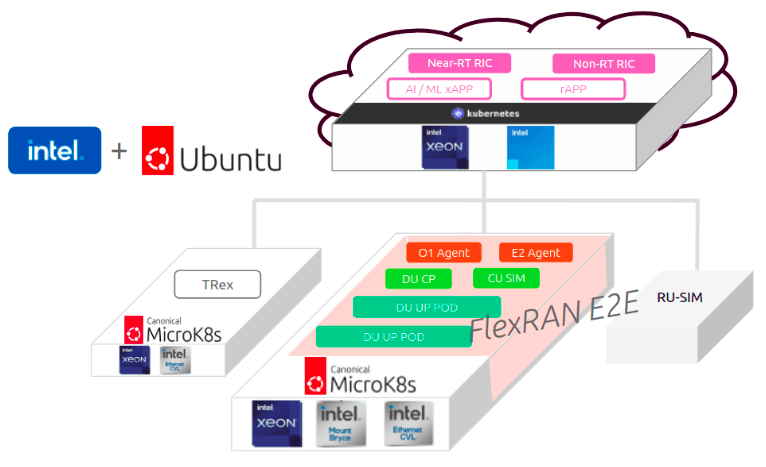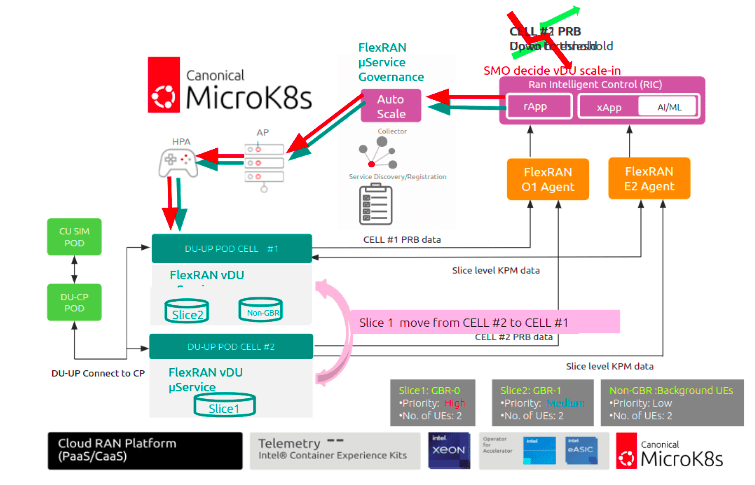Wajeeha Hamid
on 14 February 2024
Auto-scaling of Intel FlexRAN components based on MicroK8s and Ubuntu real-time kernel support
RAN has incrementally evolved with every generation of mobile telecommunications, thus enabling faster data transfers between user devices and core networks. The amount of data has increased more than ever with an increase in the number of interlinked devices. With existing network architectures, challenges lie in handling increasing workloads with the ability to process, analyse and transfer data faster. The 5G ecosystem requires virtual implementations of RAN. Fifth-generation mobile networks demand more flexibility to adapt, scalability to meet network conditions on run time, and automation for remote management which could only be delivered through virtualised RAN.
Intel FlexRAN addresses the challenges of traditional RAN architectures. It has the ability to abstract the underlying hardware from core network functions for optimal resource utilisation. FlexRAN is an enhancement and reference implementation of O-RAN (OpenRAN) with the flexibility of interoperation between different vendors’ equipment. Support for EPA (Enhanced Platform Awareness) features empowers Intel FlexRAN to optimally run on Linux distributions. Canonical’s Ubuntu real-time kernel support and Intel’s FlexRAN both complement each other to enable telcos and mobile operators to scale resources as per needs and benefit from cost-savings. Watch a detailed webinar here.
Canonical’s Real-time kernel for Intel FlexRAN
Canonical is delivering optimised, secure, and efficient server images for telecommunication workloads and enabling 5G adoption by providing real-time kernel support in Ubuntu 22.04 LTS. Real-time kernel delivers optimal performance and low latency for network sensitive workloads and security features. It enables thread scheduling by pinning cores to processes. It isolates and dedicates the cores to both host and applications for optimal resource utilisation.
Intel and Canonical contributed efforts to deliver scalable and reliable Intel FlexRAN reference RAN software with Ubuntu real-time kernel and Canonical strictly confined MicroK8s . Strict confinement uses the security features of the Linux kernel, including AppArmor, seccomp, and namespaces to prevent applications and services from accessing the wider system. FlexRAN comprises a control plane and agent API. Agent API separates the control plane from the data plane. Hence, separation provides a cost-efficient and reliable RAN environment.
Demo: Real-time auto-scaling of vDU in 5G RAN network
Canonical and Intel, jointly performed the auto-scaling of 5G RAN components, i.e vDU, and demonstrated that in MWC, Las Vegas 2022. The test setup comprises Canonical’s MicroK8s cluster enabled with Ubuntu real-time kernel, Intel FlexRAN, and Intel accelerators.
In this demo, RAN components are deployed in microservices architecture on Canonical’s MicroK8s cluster. The example here represents a real life scenario of a stadium with high bandwidth demands for autoscaling resources. Under normal circumstances, 5G entertains requests including file transfers, messages and general communications. Bandwidth utilisation is reasonable with guaranteed SLAs. Contrarily, in case of massive events, 5G needs to serve requests for applications including Virtual Reality (VR), live streaming, online sharing, high-quality streaming that requires higher bandwidths.
The figure below represents the proposed high level architecture for how FlexRAN’s components are running on top of Ubuntu with a real-time kernel. Trex traffic generator is deployed in one MicroK8s cluster, Intel FlexRAN is deployed on another MicroK8s and RAN Intelligent Controller is deployed on a native Kubernetes cluster. Intel FlexRAN’s microservice governance continuously collects vDU telemetry metrics via O1 agent. Thus, ensuring the SLA with Artificial Intelligence (AI) capabilities under high concurrent and dynamic workloads.

DU functional block comprises two microservices; first DU CP and second DU UP. Microservices enable flexibility to scale DU compared to traditional deployment models. In the figure below, three network slices were deployed hosting two UEs each with different scheduling priorities. Slice 1 – GBR0 with higher priority, slice 2 – GBR1 with medium, and slice 3 – Background UEs with the least priority. A traffic generator is used to increase traffic to a certain threshold.

The DU-UP pod reports cell utilisation metrics to RIC via O1 agent. RIC is a software-defined component providing advanced control functionality with efficient radio resource management using AI/ML capabilities. When the network load increases above the threshold, SMO sends a signal to the Intel FlexRAN microservice governance pod to horizontally scale out vDU. As a result, slice 1 is migrated to the newly deployed DU-UP pod to ensure SLA and QoS and when the network load decreases, Cell # 2 is deleted. The runtime monitoring of metrics has also been recorded to ensure intelligent decisions based on the traffic situation.
Watch the full demo recording from MWC Las Vegas, 2022 following a high-traffic scenario in a public event and understand how the user traffic has been shifted from one DU to the newly created DU cell site in real-time and what is the role of RIC in this autoscaling of RAN components.




